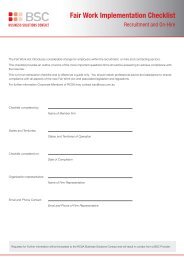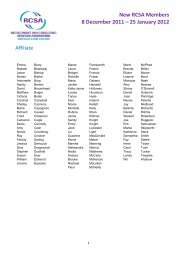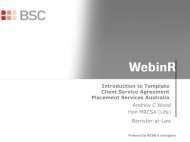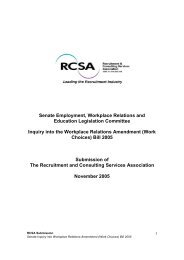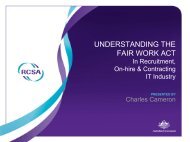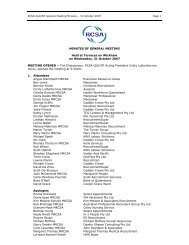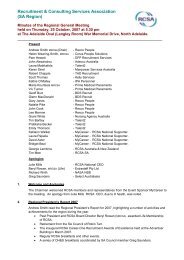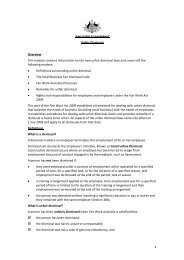June 2012.pdf - RCSA
June 2012.pdf - RCSA
June 2012.pdf - RCSA
You also want an ePaper? Increase the reach of your titles
YUMPU automatically turns print PDFs into web optimized ePapers that Google loves.
Association news<br />
Adherence to best practice in<br />
service delivery is improving<br />
The Service Delivery Rating<br />
has seen significant and<br />
sustained improvement<br />
over the past five years. This<br />
suggests more agencies are<br />
measuring-up better against<br />
recruitment industry best<br />
practice and statutory<br />
compliance.<br />
The Service Delivery Rating has been<br />
measured on certified <strong>RCSA</strong> Members<br />
since 2004. The rating is a score that can be<br />
assessed when agencies are audited in the<br />
<strong>RCSA</strong> Service Delivery Standard (<strong>RCSA</strong> SDS).<br />
The rating takes into account the<br />
performance of each agency against a range<br />
of measures including recruitment industry<br />
best practice and statutory compliance.<br />
The maximum rating is 10.0, the minimum<br />
acceptable rating is 5.0. A rating of less than<br />
5.0 can be and sometimes is assessed, but<br />
such results are not included here.<br />
Current Ratings Profile<br />
The rating of all agencies currently certified<br />
in the <strong>RCSA</strong> SDS is shown in Table 1. Of all<br />
agencies certified, 22 per cent have scored<br />
between 5.0 and 5.9. These are mainly the<br />
agencies which have been through their first<br />
audit and have just become certified in the<br />
<strong>RCSA</strong> SDS. Agencies usually start at this level<br />
and progress upwards, although there is one<br />
agency which achieved a rating of over 7.0<br />
in their initial certification.<br />
Thirty-two per cent of agencies have scored<br />
between 6.0 and 6.9, and a further 32 per<br />
cent between 7.0 and 7.9. These are mainly<br />
agencies which have been through the initial<br />
certification and have undertaken one or more<br />
subsequent surveillance audits. At each audit<br />
they are presented with a list of suggestions<br />
for improvement, which, if implemented<br />
effectively, assist them to improve their<br />
service delivery and of course their rating.<br />
Fourteen per cent of agencies have scored<br />
between 8.0 and 8.9. In all cases these are<br />
agencies which have been certified in the<br />
standard for a number of years – at least<br />
three, but more often five or more years.<br />
While we have seen a significant increase<br />
in the ratings since these measures have been<br />
collected we have not yet seen an agency<br />
assessed at more than 9.0. However we are<br />
hoping that this will happen in the next few<br />
years.<br />
How does the rating work<br />
The <strong>RCSA</strong> SDS was developed by the <strong>RCSA</strong><br />
in 2004 and 2005. Based on international<br />
standards for quality management, it also set<br />
a benchmark for recruitment excellence by<br />
including recruitment specific items such as<br />
checking a candidate’s right to work and<br />
complying with candidate privacy requirements.<br />
Over the years the assessment process has<br />
been updated to reflect emerging best<br />
practice around the use of social media,<br />
workplace safety management, employee and<br />
contractor agreements, and management of<br />
candidate “floating” (reverse marketing).<br />
The <strong>RCSA</strong> SDS standard consists of eight<br />
broad areas which are then split into 47<br />
sections such as employment screening,<br />
placement management and feedback<br />
collection. Each section is further detailed<br />
in over six hundred individual items.<br />
The rating is assessed by an independent<br />
auditor during an onsite audit over one or<br />
more days. Findings are captured in a report<br />
for the agency, and the rating is recorded in<br />
our database. Agencies that meet<br />
requirements are certified in the standard.<br />
Agencies that have been audited and have<br />
received a good rating can be proud and<br />
confident that they meet industry best<br />
practice, comply with key legislative<br />
commitments, and have established<br />
strong service delivery systems.<br />
Does size matter<br />
One of the questions we have had is what<br />
drives good service delivery It is easy to<br />
assume that the bigger businesses have access<br />
to more resources and can therefore put more<br />
effort into meeting industry best practice. In<br />
fact, size seems to have nothing to do with it.<br />
Table 2 shows a wide spread of average<br />
and maximum ratings for different sized<br />
agencies, based on the number of staff. The<br />
highest average rating is indeed for a larger<br />
agency (rating 7.6 for G 66-85 staff), but the<br />
maximum rating is for E 26-45 staff (rating<br />
8.7), and the smallest businesses (A 1-5 staff)<br />
often outperform the bigger businesses.<br />
Then we have asked, (Table 3) if it is not size,<br />
then perhaps it is the area of specialisation<br />
that makes a difference For example, one<br />
can assume that an agency placing medical<br />
doctors, where the risk of a “bad” placement<br />
could be very serious, might implement best<br />
practice more readily than an agency placing<br />
short term blue collar staff, where the<br />
consequences of a bad placements may<br />
not be so severe.<br />
But again, specialisation seems to have<br />
nothing to do with it. Out of the four main<br />
34<br />
<strong>RCSA</strong> JOURNAL



